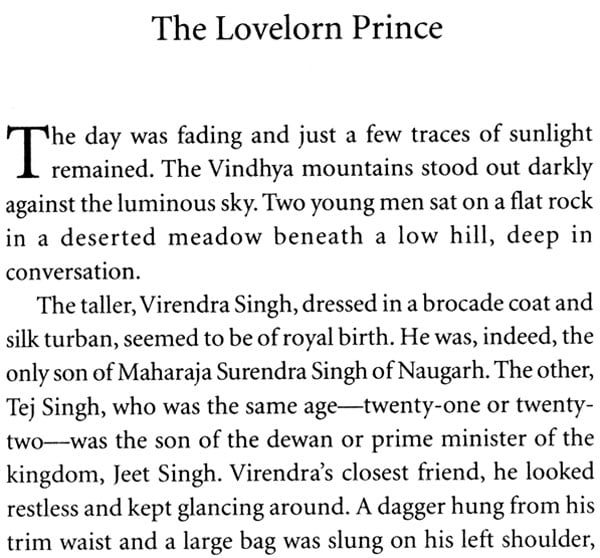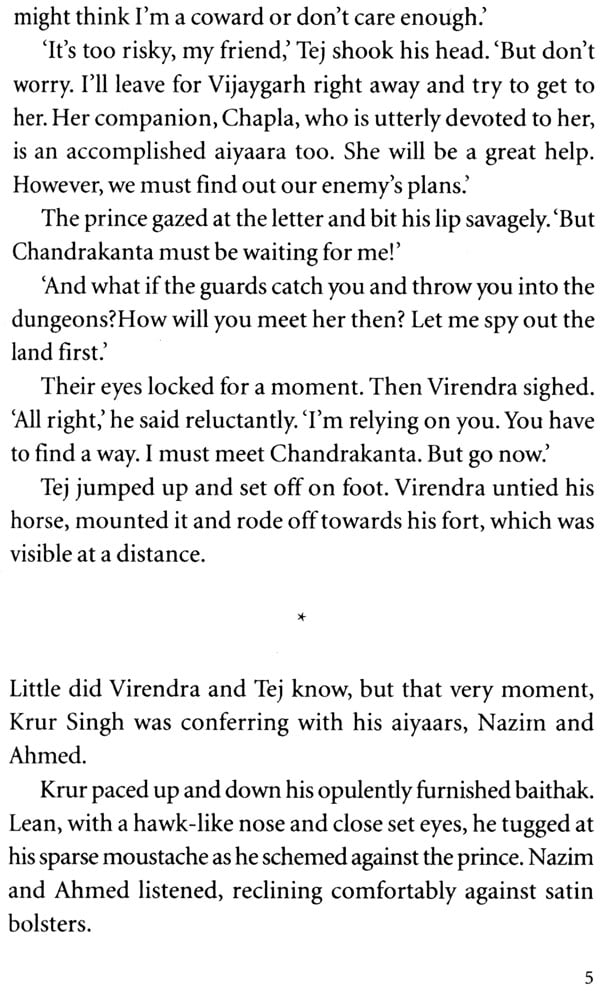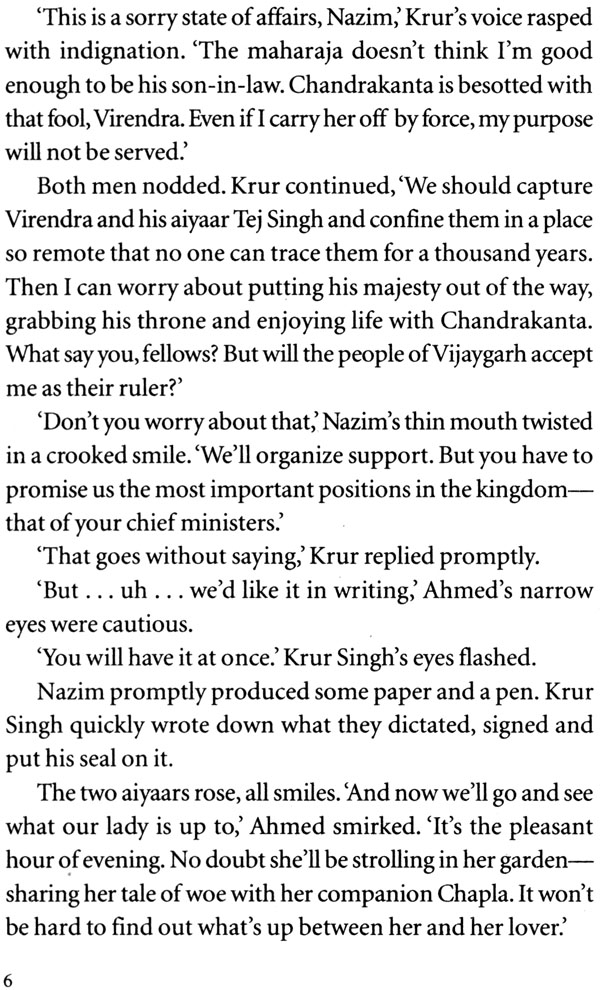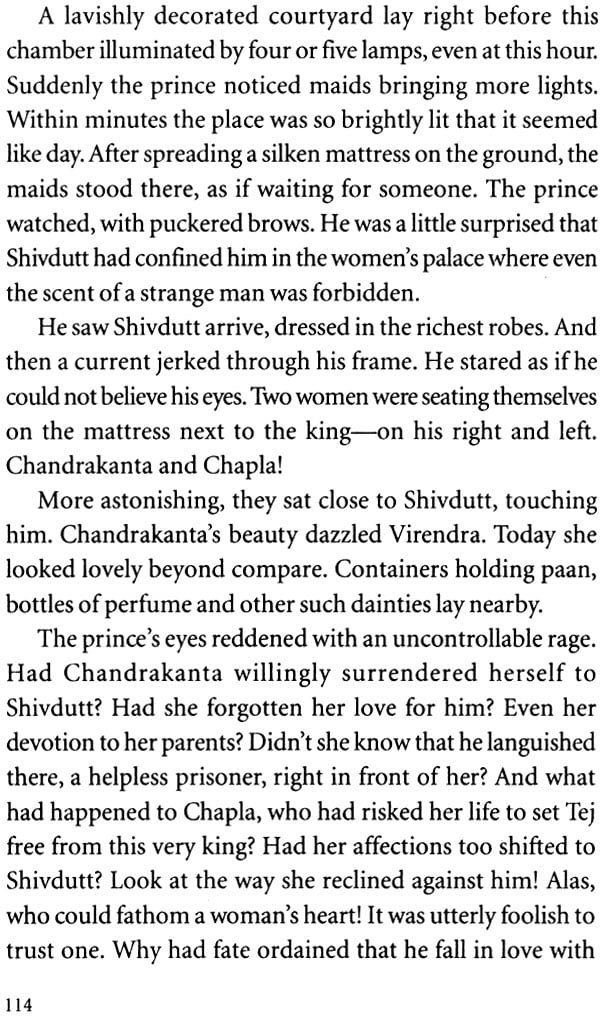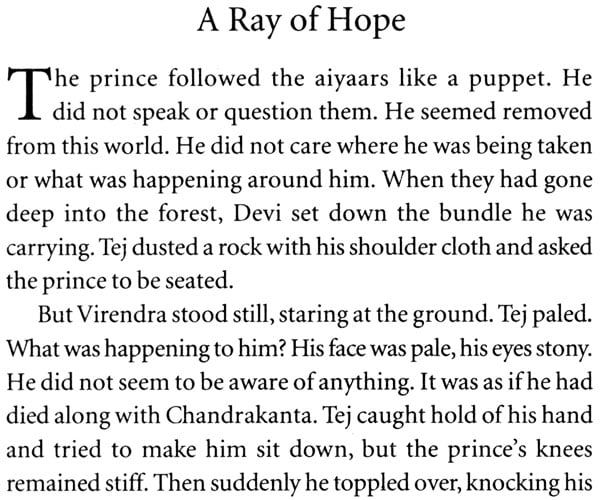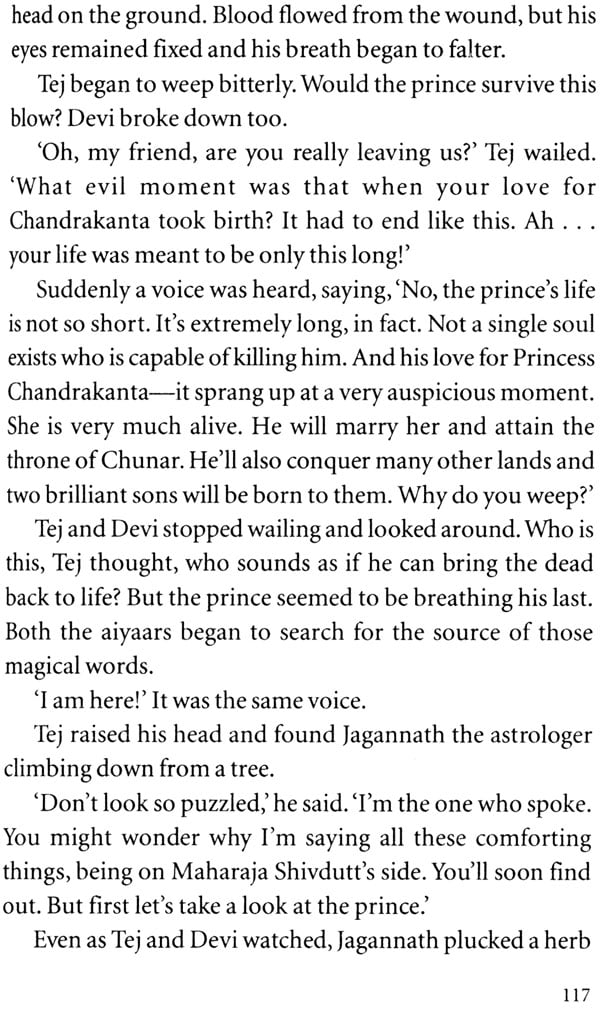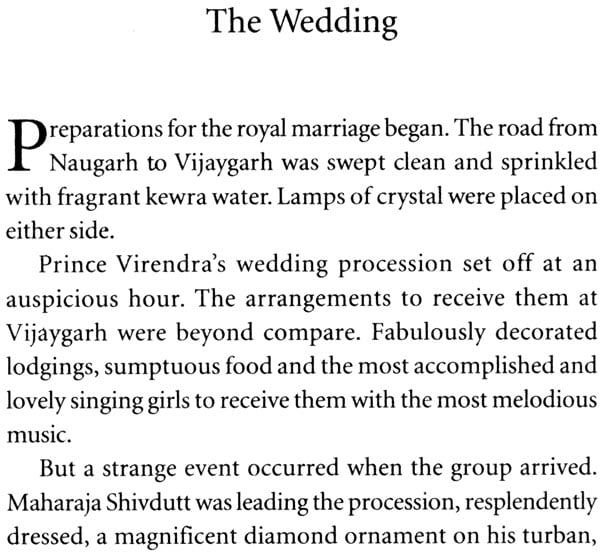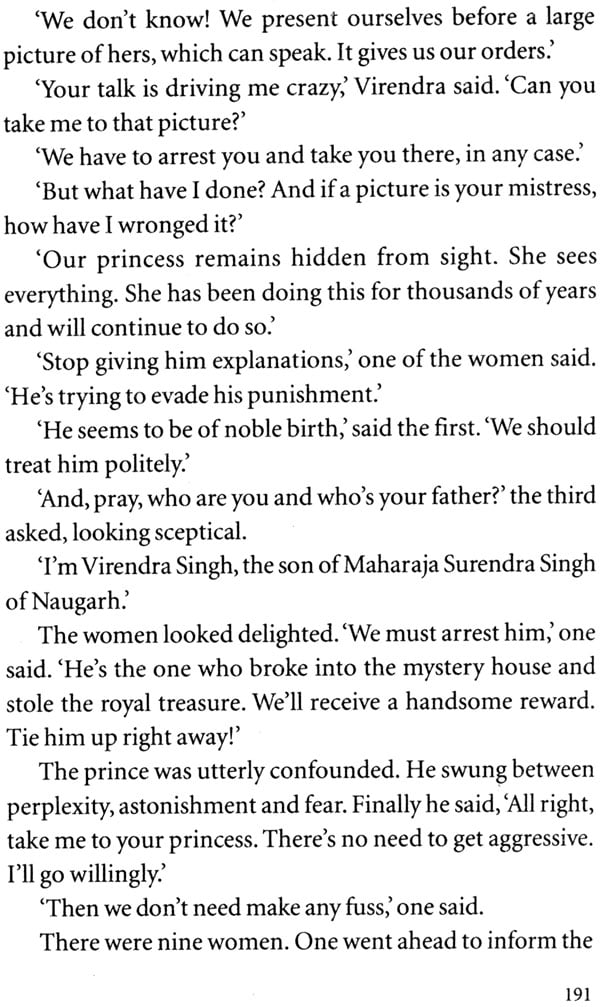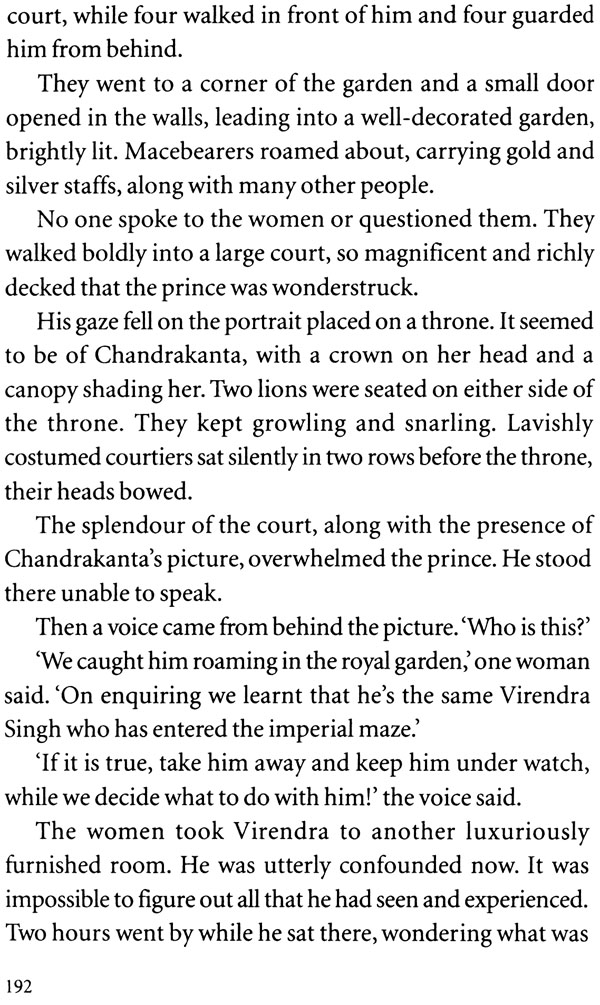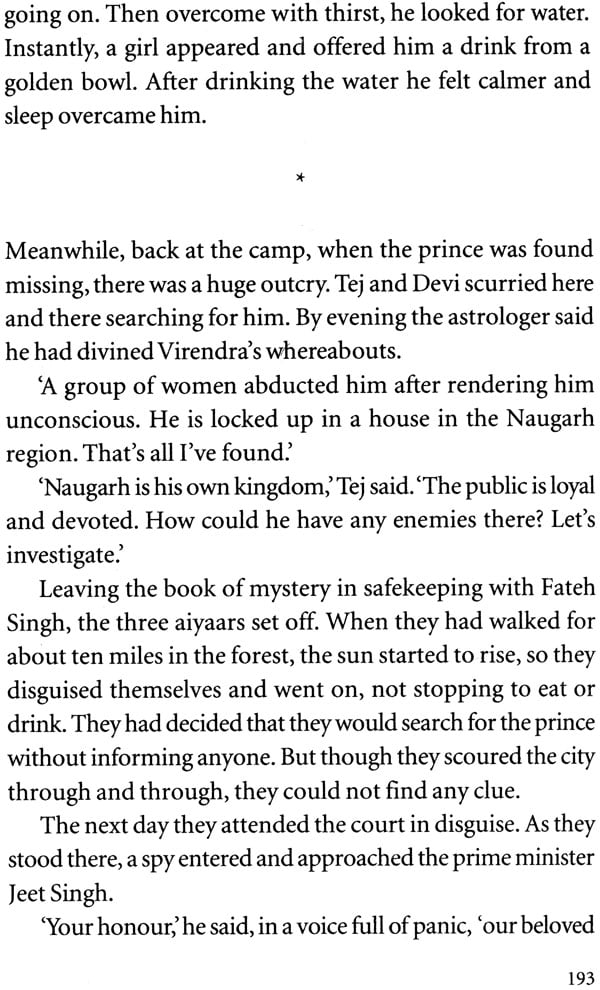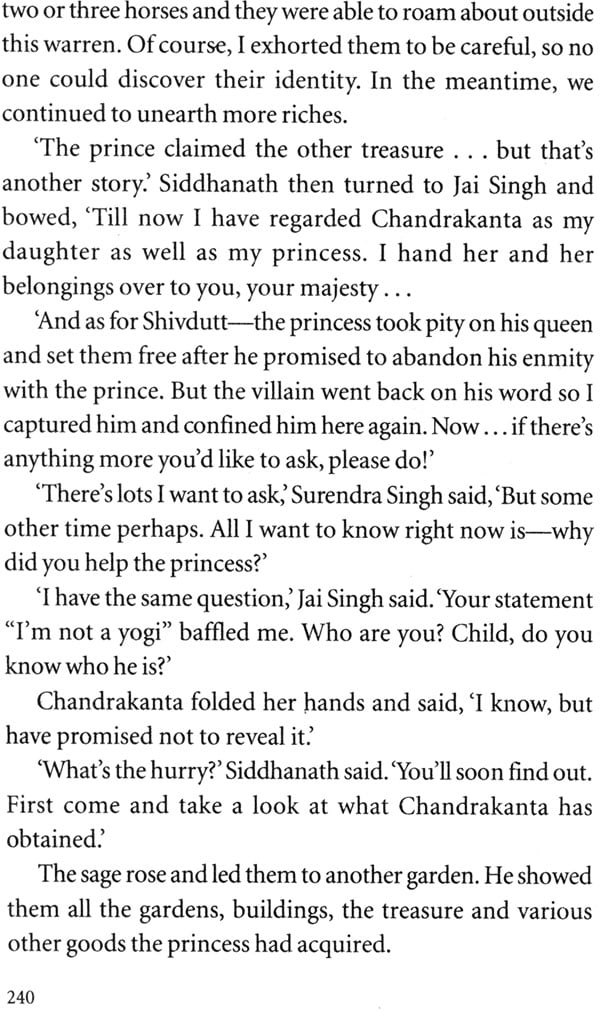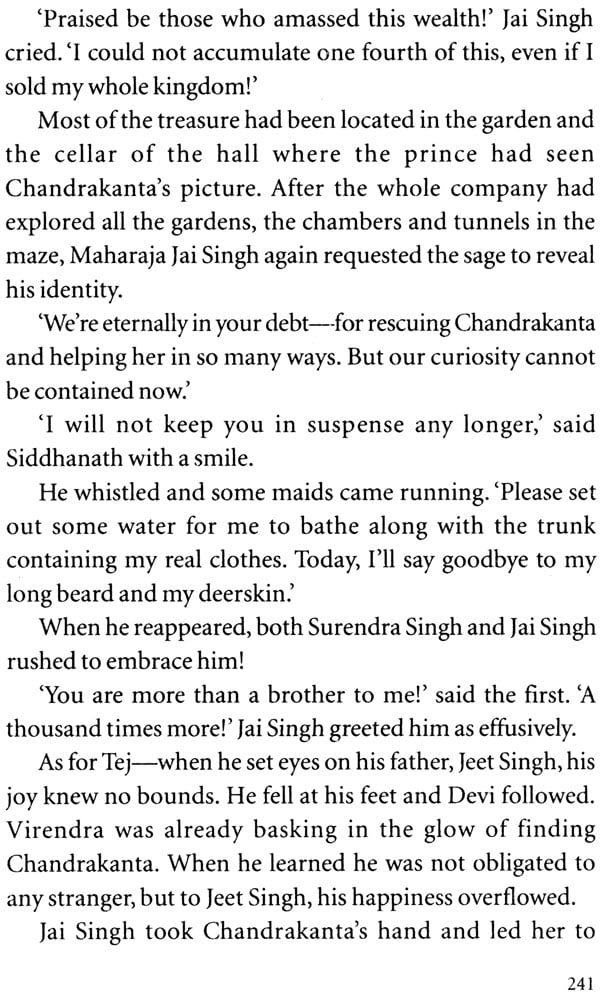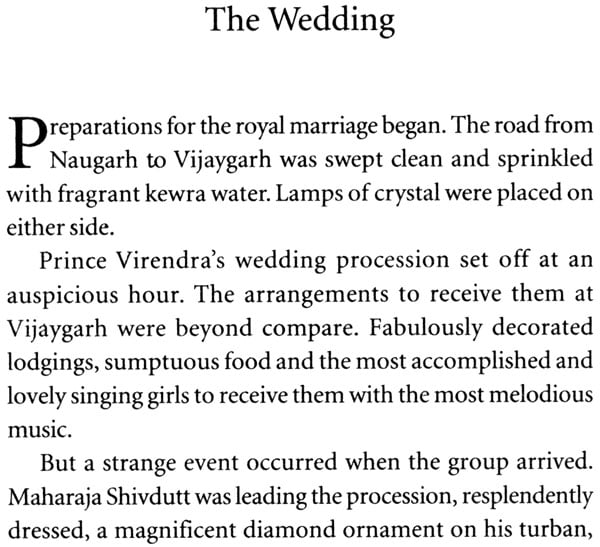
Devakinandan Khatri's Chandrakanta: A Classic of Indian Literature
Book Specification
| Item Code: | IHL343 |
| Author: | Prasoon Joshi |
| Publisher: | Penguin Books India Pvt. Ltd. |
| Language: | English |
| Edition: | 2008 |
| ISBN: | 9780143330417 |
| Pages: | 255 |
| Cover: | Paperback |
| Other Details | 7.0 Inch X 5.1 Inch |
| Weight | 200 gm |
Book Description
Chandrakanta’s eyes grew wide when she discovered a huge stone crane right in the middle of the ruins. The movement she drew closer, the bird opened its mouth. Alarmed, Chandrakanta moved away, and accidentally stepped on a stone slab. Immediately, the crane swung around, opened its beak and swallowed Chandrakanta!
The dashing Prince Virendra of Naugarh is madly in love with the breathtakingly beautiful Princess Chandrakanta of Vijaygarh. But there are obstacles galore in the paths of the lovers. There are evil ministers with sinister magicians at their beck and call, enemy kings only too happy to go into battle, masters of disguise who can fool the cleverest of spies, and magic all around. Then Chandrakanta gets trapped in a fantastic maze, from which only Virendra can rescue her. But will he be able to decipher the clues, follow the trail correctly and get to her before it is too late? And will their friends, Tej Singh, Chapla and the others, help them adequately with their deep knowledge of the art of divination and disguise?
A rollicking story of fantasy and adventure, Chandrakanta has been read and loved since 1888, when the book was published serially in short chapters. The first mystery novel in Hindi, and the biggest popular bestseller of its age, Chandrakanta was a trailblazer. This modern translation and retelling of a gem from Indian literature is sure to mesmerize a new generation of readers.
Introduction
In a somewhat rickety jam-packed state government bus heaving down a winding road from Almora to Haldwani en route to Delhi, sat a bony twelve—year—old bespectacled boy crammed near a window seat, holding tight a shaking book with both hands, eyes burning into the bouncing text. This is what I remember so vividly of my first mesmerizing encounter with Babu Devakinandan Khatri’s Chandrakanta and his mahajaal.
A restless traveller with awkwardly long legs, I used to hate sitting cramped up and eagerly looked forward to any _ stop where I could get off, stretch my legs, sample a roadside snack and explore the surrounding area. But during that particular journey, I sat inside the bus mindless of the stops. In fact a kind of a rhythm had been established between the movement of the bus and the world of the tilism; a static bus was a break in that rhythm. It was a fantasy so gripping and fascinating that when I looked around I started to imagine an aiyaar in my fellow passengers. An encounter with reality was not desirable: it jarred compared to the world Babu Devakinandan Khatri had invented.
Later, I was to realize that I wasn’t the only one entrapped in the world of Chandrakanta and Virendra’s love story that played out against a backdrop of warring kingdoms, with mysterious and endearing characters like Chapla and Tej Singh, the vile Krur Singh and Shivdutt, and my favourite aiyaars and aiyaaras. Generations of young and old alike had been ensnared by the magic of this tale and have distinct memories of when they first read Chandrakanta and its sequel Chandrakanta Santati. They remember borrowing the book from an uncle to while away time on a train journey and reading it through the night in dim light; or escaping to the chatt (roof) of the house to continue reading uninterrupted; of hiding the book from an overzealous father who thought it wasn’t a subject fit for children; of coming across the book in a library and begging for it to be issued; of tenth standard grades suffering due to the obsession with reading all the volumes of the book; of being surrounded by grown men who could not read Hindi and being begged for the story to be read aloud to them.
Chandrakanta is a swashbuckling adventure, with warring armies, sword-fights, treason, deception, gallantry against magical creatures and in dire situations. With their omnipresent bag of tricks the aiyaars—specialists in warfare and spy work, masters of disguise and magical powers—could impersonate any person, or sometimes even an animal, often with the noble intention of furthering his king’ s cause. Woven into this tale is a tilism—a kind of maze containing many secret passages, traps and prisons—which to be ‘broken’, or deciphered by a chosen person. The person who successfully breaks the tilism gains the immense treasures hidden within it.
The land is described in detail and you can picture the area, as well as the mood, vividly. The battlefields, dark caverns, forests or the beautiful secret prison where the aiyaars keep their prisoners safe, are places that one can never forget. The secret prison with its hills, waterfalls, gentle breeze rustling the jamun trees, the peacocks dancing are so wonderfully depicted that you feel you are really present there. The characters are described and developed in detail, be it the beautiful Chandrakanta and Bankanya or the ‘dakini’ Surajmukhi.
It’s a documented fact that this book by Devakinandan Khatri made a strong contribution to the learning of the Hindi language by the people of the times.
In the ancient period of Hindi or Adi kaal (before AD 1400), Hindi literature developed in the northern states of Kannuaj, Delhi, Ajmer and adjoining areas. It was during this period that the famous Prithviraj Raso was written by Chand Bardai, considered one of the earliest works in the history of Hindi literature.
The Bhakti Movement left its influence on medieval Hindi literature and long poems and epics were composed during this time. Avadhi and Braj were widely used dialects. A priceless classic from this era is Tuslidas’s Ramcharitmanans. This was also the age of tremendous integration between Hindu and Islamic elements in the arts.
During the late 1800s khadiboli developed amongst educated Hindus. Khadiboli was heavily sanskritized. It was also called Sahityik Hindi (literary Hindi). To A distinguish themselves from the general masses, learned Muslims now wrote in Urdu which borrowed from Persian and Arabic vocabulary. Soon Urdu became the dominant language of the classes and much of the masses alike.
It was in this milieu that Devakinandan Khatri wrote Chandrakanta. It is considered to be the first authentic work of prose in Hindi in the Adhunik kaal (modern period). This book brought the Hindi language alive and into the limelight although many terms are of Urdu origin. People were so eager to know what happened next, they started to learn Hindi just to be able to read the works. The author wrote “bayans’, or chapters, and these were published and distributed widely. People would enthusiastically await the new bayans which, legend has it, were auctioned hot off the press.
It wasn’t that Hindustani culture had a dearth of fiction. Storytelling is a part of our ethnicity and has a rich tradition. And whilst words are important everywhere, in India the spoken word has always played a pivotal role. Our country has an enviable oral culture. Stories and fantasy tales have been recited through generations. Folktales and even epics have been passed from one generation to another without the use of written words. Recitation and listening, in forms like katha vachan, are still alive in India.
But while many stories are contextual, only a few transcend boundaries and find place in the minds and hearts of generations to come. There is something about Chandrakanta that remains suspended in time.
But what was it apart from the writing that captured the minds of readers? There was no social statement; no revolutionary thought. Was it pure entertainment?
I think much of Chandrakanta’s popularity also had to do with our belief in miracles. Do miracles have any place in our modern, scientific lives? Consider this: while surfing television channels mid afternoon or late night, have you paused at teleshopping programmes selling products you would never find anywhere else? It’s called interactive home shopping. Through the programme innovative appliances usually not available in traditional outlets are sold. That’s what the marketing definition would, I presume, say. Delve a little deeper and various other versions come up.
Let’s look at the products they sell: A steam tent that you can sit comfortably under and lose weight; except that it looks like you are being swallowed by some alien entity. Machines, belts which are plugged around your waist, working away those muscles’ while you go about doing your regular (in) activity. Lotions that promise to make you fairer or taller; an apparatus that will make naturally wavy hair poker straight; a wonder drug for diabetes . . . The list of these tasteless products is endless.
Or go to a mela and take a look at the amazing exhibits: a magic potato peeler that can undress a dozen potatoes in less than half the time; a duster that will dust every crevice of the impossible to clean cassette racks; haldi stain removing liquid; a wonderful soda maker promising “cold drinks’ at home. Even the most prudent buyer in us cannot help but stop and watch for a while before flicking channels. Our logic questions the products but I have known many to have punched that number and ordered a cream, a belt, a powder, all in the hope that it will produce the miracle we so hope for.
My belief is these products play on our wish for magic. There is an underlying, rarely acknowledged thought within many of us that there maybe something out there which is being kept hidden away. If we find it, we will get what we desire. Have we not at one time or the other wished for a time machine, hoped to discover something as miraculous as Aladdin’s lamp, imagined a hidden treasure in the ancestral home, dreamed that in the snake hole in the tree trunk there could be a paras mani, or that if we followed the rainbow to its other end there just might be that pot of gold.
So when you read about the amazing qualities of the stone flowers that Virendra and Tej Singh discover in the tilism - of the rose flower that acts like a knock-out drug or the oruhar’s paste that ensures hunger doesn’t strike for four days or how the exhaustion of a thousand-mile journey vanishes when the traveller’s feet are washed in the paste of the oleander flower—a chord is struck.
If the world was only about logic and reality then there wouldn’t have been emotions, relationships, exceptional sacrifices, heroic deeds and passion. Pandit Omakarnath Thakur, a renowned Hindustani classical vocal artist, wanted to sit in a lion’s cage and sing, confident that no harm would come his way, such was his belief in the power of his music, his art.
Ordinary facts from our everyday life—•that we can fly to. Our destination, or we can talk to people thousands of miles away through a small instrument - all started with a dream and a belief in what seems to be miraculous.
I am personally a huge admirer of Darwin’s revolutionary work. His theory of evolution and natural selection should have destroyed belief in God or a higher power—especially in the West. But it was not for weakness in the logic of Darwinian theory but the poetry in the concept of God, that billions have kept their faith alive. Your mind may question the existence of God but your heart accepts it fully. I Chandrakanta reintroduces us to that side of our being that wants to believe in wonders.
Devakinandan Khatri was a colourful personality He was a warm—hearted gregarious man who loved exploring ruins of old forts and ancient structures near his hometown and areas where he worked. The strange tunnels and surprising trap doors that he discovered in the forests of Chunar kindled his interest in mystery writing.
He wrote Chandrakanta and much of Chandrakanta Santati sitting on a takth, or a marble platform in Sri Har Mandir in Bihar. There are some who claim that his inspiration was Dastaan-e-Amir Hamza, a Persian work written earlier and performed by Dastangos all over Delhi and north India in the early part of the twentieth century. But I would like to believe that such a large volume of work I could be produced only by an original thinker. Only a truly great writer could have created so enthralling an epic- romance with such variety of scene and character, such ingenious largess in creation and portrayal with so much pace and humour in the narrative that readers irrespective of age are left as eager as wide-eyed children for what’s going to happen next.
Chandrakanta Santati is a much more monumental and complex work than Chandrakanta, spread over six thick books. It is the story of the sons of Virendra Singh and Chandrakanta, and has the added attraction of a mysterious aiyaar called Bhootnath, who has a magical dagger. Bhootnath played such an important role in the book that there followed a separate book on him, called Bhootnath which in fact ran into seven volumes. Devakinandan Khatri also wrote many other works including Kajar ki Kothari and Gupta Godana. His son, Durgaprasad Khatri, had a pivotal role to play in the development of the later works but no one can doubt the storytelling prowess of Devakinandan Khatri.
I still remember sitting in the Zilla Pustkalay of a small district of Rampur. My father was a district level officer and had the jurisdiction of the library as well. But he was unaware that using his clout I would get the library opened up at odd hours in the afternoon or late evenings. It’s here that I discovered a treasure trove of books and with my appetite already whetted by Chandrakanta, read more books on jaadu and tilism. It was sometime before I could lay my hands on Chandrakanta Santati. I devoured whatever I could find of that genre of literature in that library. Many a times I have thought of making that journey back to Rampur if only to ensure that this rare form of writing is preserved for many more years; that the surreal world it depicts continues to exist in the minds of those fortunate enough to have come by it, as it does in mine.
I was indeed fortunate to have read Chandrakanta in Hindi when I was a child and I congratulate Puffin for unearthing this gem and bringing it alive for this generation. For whilst children and adults are enthralled by The Chronicles of Narnia and Harry Potter, to be introduced to the kind of world. an Indian writer had brought alive nearly hundred years ago is amazing.
When you read this book you will understand the power of writing and the beauty of narrative. There’s a delicious immortal magic in this work.
Read the book and you will know that a tilism can be cast only by an accomplished person. It is an enchanted zone which is both a physical reality as well as an imaginative effect. It seems that Babu Devakinandan was a sorcerer in disguise for he created in Chandrakanta such an enchantment that it has a magical effect. So fasten your seatbelts and get ready to embark upon a journey that will take you into a world you will never want to leave.
| Introduction by Prasoon Joshi | vii |
| Chandrakanta | 1 |
| Translator’s Note | 247 |
| Classic Plus | 253 |
